Applicability of Munition Safety Standards
Applicability of Munition Safety Standards – An example of a investigation into the need to assess fuzes systems against the rain impact.
The application of munition safety requirements, and assessment using standards, depends on many factors: the nation conducting the assessment, munition type, environmental lifecycle profile and phase of the lifecycle. It is often the case that questions arise on the basis of a particular test standard and whether it is still required. At this point it is useful to undertake some research to understand the science behind the requirement to determine the basis of a particular test and whether the threat still relevant. MSIAC was asked to look at the justification for conducting a rain or hail impact test on fuzes (e.g. MIL-STD-331or NATO AOP-20 ANNEX D Appendix D-5).
In order to assist, an assessment of the threat was undertaken to determine the relevance for artillery fuzes. The analysis, focused on impact energies of typical rain for this type of system. Assessment was then undertaken to answer the following questions:
- Is rain and hail impact an issue?
- What are the possible mechanisms of failure?
- Erosion of the fuse
- The possibility of inadvertent initiation due to misinterpretation of the rain and hail approach and /or impact as conditions for functioning.
To address these questions the analysis provided some details on the following:
-
Impact energy table for different intensities of rain and hail
-
Comparison of the energy level to other projectiles
-
An estimation of the hit probability for firing projectiles into a rain or hail storm
-
Some discussion on damage
-
A very brief extract of references on this topic
-
Impact Energy
The following table gives an indication of the kinetic energy of the impact of a single droplet or hail particle. These are calculated using the assumption that the droplet or hailstone is travelling at the speed of the projectile, hence the projectile is stationary. An immediate observation is that hail with a larger typical mass is much more severe threat than rain drops which tend to be limited in size to 5mm due to aerodynamic break up effects. Clearly, another key factor is the velocity; 30/40mm projectiles traveling at 1400 m/s experience more significant impacts than large caliber shells traveling at say 600m/s. Not included or considered is influence of the fuze profile which should encourage glancing blows and oblique impacts, which will help to mitigate the effects.

-
Typical Impact Energies
In order to understand the relative energies of impact, some typical kinetic energy values are included below:
- STANAG 4241 bullet impact 12.7mm AP v=850m/s, mass 45.5g, Kinetic Energy = 16,500J
- STANAG 4496 fragment impact test v=2530 m/s, mass 18.6g, Kinetic energy = 6,000 J
- STANAG 4496 fragment impact test v=1830 m/s, mass 18.6g, Kinetic energy = 31,000 J
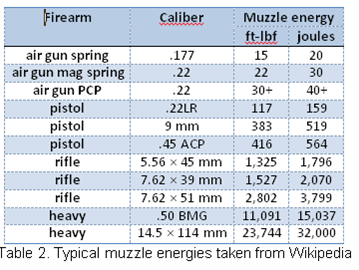
-
Probabilities of Impact
The comparison above is interesting in that firing a 30-40mm projectile into a hail storm could very well result in breakup of the round (highly likely for impact with a 40mm diameter hailstone).
The question remains as to the probability of an impact for flight through a rain or hail storm. One notable point is that for a given rain fall there is an inverse relationship between droplet size and distribution density in air; the bigger the droplets the less there are which results in a lower probability of impact.
The tables below provide details on probability in two parts. Table 3 details calculation of the distribution density for 5mm raindrops, 40 and 10mm diameter hailstones in air. The second set, tables 4 and 5, give the probability of impact on the fuze during flight for large and medium caliber projectiles fired into heavy and violent rain. The rain data was taken from a table which is referenced in the literature multiple times: R.R. Rogers, A Short Course in Cloud Physics, 2 ed. Pergamon Press, 1979.
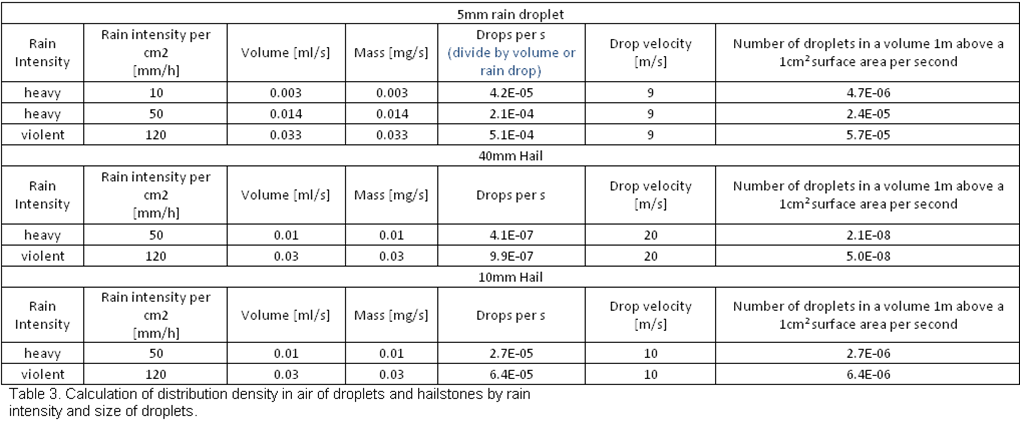
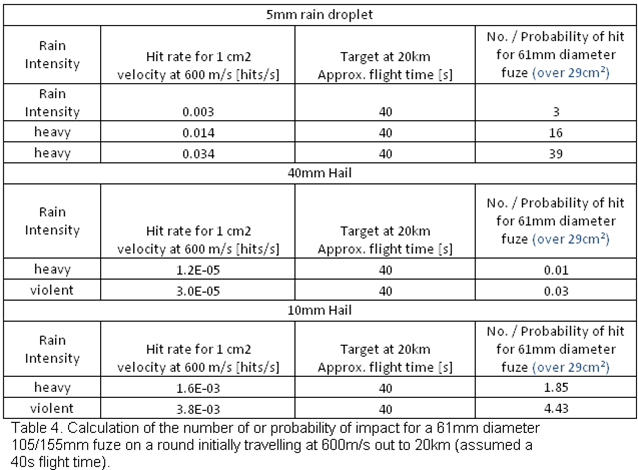
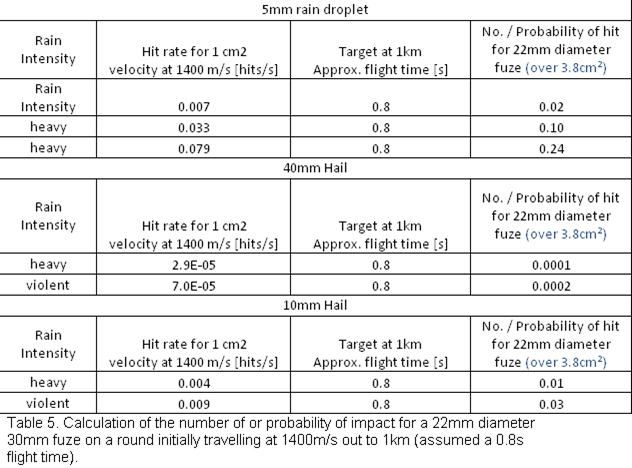
One assumption made is that at any given time the vertical and horizontal (or 1m in any direction) distribution density of droplets in air is the same. Also not included is the number of rounds fired in a real scenario.
There is no account taken for the real distribution density of droplets or hail stones i.e calculation assumes for 5mm droplets that all are this size, which clearly they will not be. Hence the number of impacts for firing through a rainstorm with a 5mm maximum droplet size will be significantly higher. No account is made for drop off of the velocity for the projectile which will also affect the flight times.
The data does indicate that the probability of impact is significant, even for the largest droplets or hailstones, and is likely to be much higher when one includes the variance of the diameter of droplets and hailstones.
-
Examples of Damage
There are a number of reports which describe the evaluation of damage for missiles warheads etc. but there are few actual examples for specific systems. It appears that the most significant concerns, from a structural point of view, are for sensors and brittle materials (often related). Brittle materials are reported to undergo damage due to the shock impact and the mechanism has been studied and characterised. There are pictures in the literature of damage to aircraft and to wind turbine blades. Although the latter move much more slowly than projectiles (90m/s max at wing tip) they do suffer after prolonged exposure. What is clear is that ductile materials are much more resistant and the exposed fuzes on artillery are likely to be resistant to the much of the damaging effects from moderate rainfall. However, introduction of new materials, and in particular composite materials, would require careful consideration.
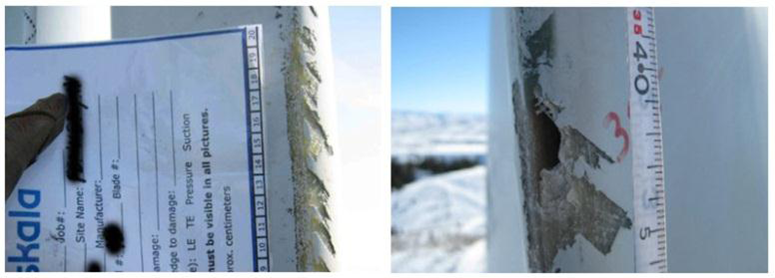
Taken from: Modelling Rain Drop Impact of Offshore Wind Turbine Blades; M. H. Keegan; D. H. Nash
-
Efforts Related to the Evaluation of Rain and Hail Impact
Some research into the literature has identified communities currently interested in the effects of rain and hail impact. Below is a small selection of reports which have identified:
- ‘PRELIMINARY INVESTIGATION OF HIGH-VELOCITY LIQUID IMPACT DAMAGE’; RAY KINSLOW, VIRESHWAR SAHAI, AND JOHN PEDDIESON, JR., U.S. ARMY MISSILE COMMAND REDSTONE ARSENAL ALABAMA ' -CONTRACT NUMBER OAAHO1-72-C-0375 Dec 1972. Investigation of liquid impact damage of materials using water jet and comparison with radome surface after a sled test through a rainfield.
- ‘An Experimental Method for the Study of the Impact between a Liquid Drop and a Surface Moving at High Speed’ D. C. JENKINS, B.Sc., A.F.R.AE.S., J. D. BOOKER, A.F.R.AE.S., and J. W. SWEED; MINISTRY OF AVIATION, R. & M. No. 3203. AERONAUTICAL RESEARCH COUNCIL REPORTS AND MEMORANDA (UK) 1961. I quote ‘The forward-facing surfaces of an aircraft or missile in high-speed flight through rain may suffer severe damage due to the impact of the raindrops’. An experimental test method is described. The picture below shows the damage to a aluminum alloy by a 2mm droplet at about 1000 m/s.
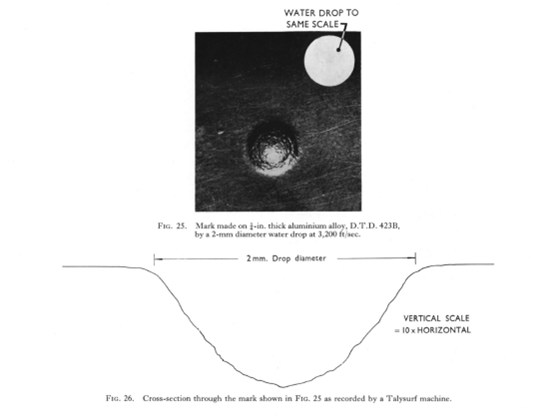
*Note: Using the Information above, 1mm erosion for a 2mm diameter droplet, and the droplet distribution density in air for heavy rain, one could consider over the 1cm2 section of the fuze nose that 12 hits during 40 seconds flight for a 105mm shell could equate to: erosion of the nose by 1-2mm.
- ‘Modelling Rain Drop Impact of Offshore Wind Turbine Blades’ ; M. H. Keegan; D. H. Nash; Proceedings of the TURBO EXPO 2012 GT2012 June 11-15, 2012, Copenhagen, Denmark. Composite damage pictures above
- ‘Damage threshold velocities for liquid impact’; JOURNAL OF MATERIALS SCIENCE 35 (2000) 5331 – 5339, C. F. Kennedy, J. E. Field Cavendish Laboratory, Department of Physics, University of Cambridge. Determination for damage thresholds for IR windows. I note also they use a liquid jet to introduce damage. See also publications at: http://www.smf.phy.cam.ac.uk/fsp/Publications/publerosion.html
- ‘ELSI conference: invited lecture Liquid impact: theory, experiment, applications.’ J E Field. Confirms interest for Brittle materials and high speed
- Note also the capabilities and teaching material at Cambridge on this topic: http://www.smf.phy.cam.ac.uk/Equipment/MIJA.html
Conclusions:
On reviewing the data, what is surprising is the energy of impact of a single large water droplet or hailstone. Given the kinetic energy involved and the efforts that has been expended by the aero and weapon design (in the past) communities it is clear that high speed impact with rain and hail is considered a problem. If one does not consider this threat during the design phase it is likely that problems may be observed when it is encountered in the environment.
One can conclude that water droplets will erode and damage a fuze and if insufficiently designed could impair or prevent functioning. However, the use of ductile materials and an angled profile for artillery fuzes should limit the likelihood of failure, with erosion being in the order of a couple of mm (*see earlier note). Adverse conditions, and in particular hail storms will increase the risk of damage to the fuze and projectile significantly. For faster moving medium caliber rounds, hailstones can easily have a similar impact energy as a 5.56mm bullet and a direct impact is likely to disrupt and could function more sensitive energetic materials in the initiation train. Without designing for, and test and evaluation for this threat, it would be wise to advise against firing when hail is imminent. At least one nation is known to cease artillery training when rain or hail is falling.
More difficult to evaluate is effect that rain or hail will have on the fuze with respect to its intended mode of function. The fuze sensor design should be sufficiently robust not to confuse the approach of hail and rain, and subsequent shock of impact, with the functioning stimulus. However, it is possible, particularly for some simple impact type fuzes, that impact with larger water droplets or hail could achieve this effect. Again, design for, and test and evaluation for this stimulus, would be required before exposing munitions to this environment.
In terms of probability, impacts when firing through rain can be expected but are much less probable than one might expect, particularly for the more damaging larger droplets (10s of hits for 5mm vs. 1000s for 1mm droplets). Fortunately, hail impact is at least a couple of orders of magnitude lower in probability, due to a lower distribution density in air and reduced prevalence in the environment. However, it is not at a low enough level where it can be ignored when considering the risk. One should also note that the risk for medium caliber round failure is exacerbated by their velocity and high rate of fire.
In summary, we can conclude that failure to assess against rain and hail impact could lead to problems particularly if consideration is not given to selection of appropriate materials and fuze sensors. What we cannot advise on is whether current fuzes are likely to fail when subjected to typical rain. Such an assessment would only be possible by the design authority and through test and evaluation, including the fuze logic. The hail impact is a much more serious problem and again suggest that testing and evaluation would be required to understand the risk to this environment.


